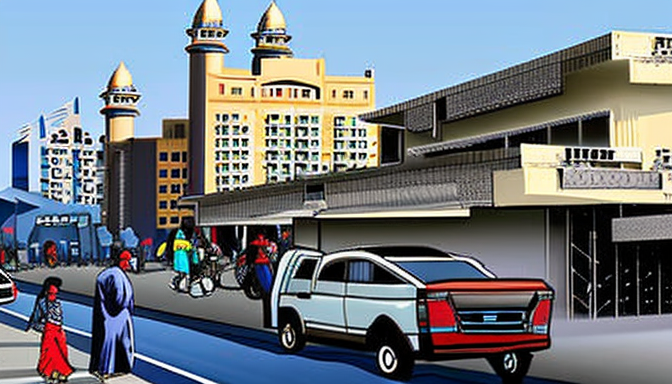Karachi, once a humble fishing village, has undergone a remarkable transformation over the centuries. This city has seen waves of change that have shaped its identity. From its early days, Karachi was a small port where fishermen cast their nets and traded their daily catch. But as time marched on, the city began to expand.
In the 19th century, Karachi became a significant trading hub. The British recognized its potential and developed its port, attracting merchants from all over. This was a pivotal moment. The city started to grow, drawing people from various backgrounds in search of better opportunities. By the early 20th century, Karachi was bustling with life, filled with markets and communities that reflected a blend of cultures.
Fast forward to the post-independence era in 1947, and Karachi found itself as the capital of Pakistan. This brought a new wave of migration. People from all corners of the country poured in, seeking refuge and a fresh start. The population skyrocketed, and with it, the city’s challenges multiplied. Today, Karachi stands as a metropolis of over 14 million people, but it hasn’t been a smooth ride.
Throughout its history, Karachi has faced numerous hurdles, from political unrest to economic challenges. Yet, the spirit of its people remains unbroken. They continue to adapt and innovate. Karachi’s journey is a testament to resilience, a city that has transformed while holding onto its roots.
Historical Milestones
Karachi’s history is like a rich tapestry, woven with threads of various cultures and events. It all began as a humble fishing village in the 18th century. Can you imagine? Just a few huts by the sea, where fishermen cast their nets and dreamed of a better life. Fast forward to 1843, and the British took notice. They saw potential and made Karachi a part of their empire. This was the first major leap for the city.
By the late 19th century, Karachi was bustling. The port was developed, and trade flourished. It became a gateway for goods flowing in and out of India. This transformation attracted people from various regions, creating a melting pot of cultures. The city was no longer just a fishing village; it was a vibrant hub of activity.
In 1947, Karachi faced another significant change. With the partition of India, it became the capital of Pakistan. This shift brought a surge of refugees. The population exploded. The city struggled to keep up. Housing, jobs, and services became scarce. Yet, Karachi adapted, as it always has.
Today, Karachi stands as a testament to resilience. It faces challenges like urban sprawl and infrastructure demands. But its spirit remains unbroken. Each milestone in its history has shaped the city into what it is today. From a small village to a bustling metropolis, Karachi’s journey is nothing short of inspiring.

Modern Challenges
Karachi is a city that never sleeps. But with all that hustle and bustle comes a set of challenges that are hard to ignore. Urbanization is one of the biggest issues. As more people flock to this vibrant city, the demand for housing, transportation, and basic services has skyrocketed. It’s like trying to fit a square peg in a round hole; the city is stretching to accommodate everyone.
Infrastructure is crumbling under the weight of rapid growth. Roads are congested, public transport is often inadequate, and waste management is a nightmare. Imagine living in a place where the traffic jams feel endless and the trash piles up. It’s frustrating, right? The city’s layout, once designed for a smaller population, now struggles to keep pace.
Moreover, socio-economic disparities are glaring. Wealth and poverty exist side by side, creating a stark contrast. Some neighborhoods shine with modern amenities, while others lack basic necessities. This divide can lead to social unrest. It’s like a ticking time bomb; the longer these issues persist, the more tension builds.
In summary, Karachi’s transformation is impressive but fraught with challenges. To truly thrive, the city must address these modern hurdles head-on. It’s a monumental task, but with collective effort, Karachi can carve out a brighter future for all its residents.
Frequently Asked Questions
- What is the historical significance of Karachi?
Karachi has a rich history, evolving from a small fishing village to a major economic hub. Its strategic location along the Arabian Sea made it a vital port city, attracting traders and settlers from various cultures.
- What are the main challenges Karachi faces today?
Today, Karachi grapples with rapid urbanization, inadequate infrastructure, and significant socio-economic disparities. These challenges impact daily life and hinder sustainable development, making it crucial for policymakers to address these issues.
- How has Karachi’s population changed over the years?
The population of Karachi has skyrocketed, transforming it into one of the largest cities in the world. This explosive growth has created a vibrant, diverse culture but also strained resources and services.
- What are some key milestones in Karachi’s development?
Key milestones include its establishment as a British port in the 19th century, the partition in 1947 that saw a massive influx of refugees, and recent developments in technology and industry that continue to shape its economy.
- What role does Karachi play in Pakistan’s economy?
Karachi is often referred to as the economic backbone of Pakistan, contributing significantly to the country’s GDP through industries like shipping, textiles, and finance. Its bustling markets and ports drive trade and commerce.